Saturday, October 07, 2006
From bad to worse for the opposition
Just when you thought things couldn't get much worse for the Venezuelan opposition, they did. Today they attempted to mount a large rally in Caracas to kickstart their to-date moribund campaign which has them trailing Chavez anywheres from 20 to 30 points. Unfortunately for them, it flopped. Here is a picture of the sad spectacle:
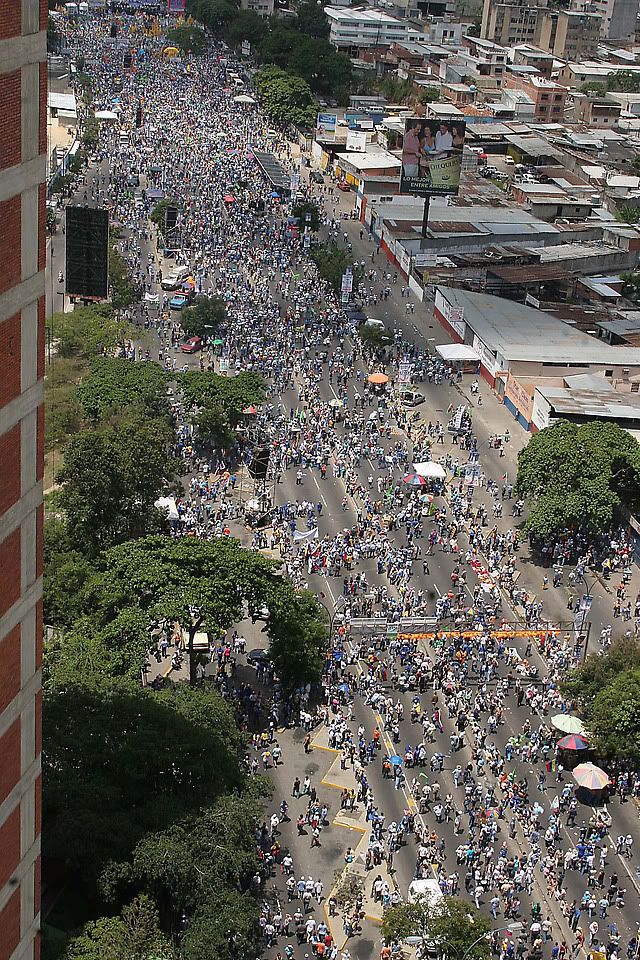
Clearly, it was sparsely attended. Associated Press reporters estimated a turn out of 10,000 people. I'll be a little more generous, from the picture maybe it was 15,000. Suffice it to say, Shakira can get a lot more people to show up to an expensive concert than these people can get to a free rally!
So bad was the debacle that their web-sites had to put up pictures of old rallies to cover this failure. Next maybe they'll be blaming the low turnout on the big tourism expo being held in Caracas (and to which people have had to wait in lines of up to five hours just to get in).
To only get ten or twenty thousand people to turnout in what is indisputably the oppositions main strong hold is a huge failure. With the refusal of Rosales poll numbers to budge and now this their campaign team is probably huddled tonight trying to figure out what to do next. The downside is that they may well conclude they have no hope of avoiding a thorough drubbing at the polls and simply go back to the "fraud" excuse for pulling out of the elections altogether. They are definitely between a rock and a hard place.
|

Clearly, it was sparsely attended. Associated Press reporters estimated a turn out of 10,000 people. I'll be a little more generous, from the picture maybe it was 15,000. Suffice it to say, Shakira can get a lot more people to show up to an expensive concert than these people can get to a free rally!
So bad was the debacle that their web-sites had to put up pictures of old rallies to cover this failure. Next maybe they'll be blaming the low turnout on the big tourism expo being held in Caracas (and to which people have had to wait in lines of up to five hours just to get in).
To only get ten or twenty thousand people to turnout in what is indisputably the oppositions main strong hold is a huge failure. With the refusal of Rosales poll numbers to budge and now this their campaign team is probably huddled tonight trying to figure out what to do next. The downside is that they may well conclude they have no hope of avoiding a thorough drubbing at the polls and simply go back to the "fraud" excuse for pulling out of the elections altogether. They are definitely between a rock and a hard place.
|
Making sure the war is unseen
Those living in the U.S. already know how well the war in Iraq is hidden from the American public. In the U.S. media there are virtually so scenes or tales of American soldiers being killed or wounded. Even pictures of coffins are banned. Great leangths are gone to in order to keep the war antiseptic. It shouldn't surprise that Bush and the Pentagon want the war kep this way but it is quite telling that the "free" media in the U.S. plays along with it.
But it gets worse. Even new media that are supposed to make the world freer are now being censored. Witness this article from the New York Times regarding Iraq videos on YouTube:
After reading this I personally checked YouTube for any videos I could find on the Iraq war. Almost everytime I found what looked like it could be one and clicked on it a message popped up say "This video has been removed for violating the terms of usage".
So the Iraq war is nowhere to be seen, not even and what is supposedly the most democratic of all media, the internet. Interesting how freedom is complete until it is something THEY don't want shown. The dead bodies of Saddam's sons, Zaqawri, or any Iraqi insurgent can be plastered all over the media the image of U.S. troops must be protected at all costs.
BTW, here are about the only videos I could find still undeleted on YouTube. Lets see how long they last.
|
But it gets worse. Even new media that are supposed to make the world freer are now being censored. Witness this article from the New York Times regarding Iraq videos on YouTube:
LOS ANGELES, Oct. 5 - Videos showing insurgent attacks against
American troops in Iraq, long available in Baghdad shops and on
Jihadist Web sites, have steadily migrated in recent months to popular
Internet video-sharing sites, including YouTube and Google Video.
Many of the videos, showing sniper attacks against Americans and
roadside bombs exploding under American military vehicles, have been
posted not by insurgents or their official supporters but apparently by
Internet users in the United States and other countries, who have
passed along videos found elsewhere.
Among the scenes being viewed daily by thousands of users of the sites
are sniper attacks in which Americans are felled by snipers as a camera
records the action and of armored Humvees or other military vehicles
being hit by roadside bombs.
....................................................
At a time when the Bush administration has restricted photographs of
the coffins of military personnel returning to the United States and
the Pentagon keeps close tabs on videotapes of combat operations taken
by the news media, the videos give average Americans a level of access
to combat scenes rarely available before, if ever.
Their availability has also produced some backlash. In recent weeks,
YouTube has removed dozens of the videos from its archives and
suspended the accounts of some users who have posted them, a reaction,
it said, to complaints from other users.
More than four dozen videos of combat in Iraq viewed by The New York
Times have been removed in recent days, many after The Times began
inquiries.
After reading this I personally checked YouTube for any videos I could find on the Iraq war. Almost everytime I found what looked like it could be one and clicked on it a message popped up say "This video has been removed for violating the terms of usage".
So the Iraq war is nowhere to be seen, not even and what is supposedly the most democratic of all media, the internet. Interesting how freedom is complete until it is something THEY don't want shown. The dead bodies of Saddam's sons, Zaqawri, or any Iraqi insurgent can be plastered all over the media the image of U.S. troops must be protected at all costs.
BTW, here are about the only videos I could find still undeleted on YouTube. Lets see how long they last.
|
Thursday, October 05, 2006
Terrorists?
Maybe I'm a little slow but I just noticed some curious wording in U.S. military press releases like this one:
So U.S. soldiers and some Iraqis got in a shoot out and four Americans were killed. Ok, they weren't just any Iraqis, they were insurgents, right? Not really, according to the U.S. military. They called them "terrorists".
Huh?!?! I thought terrorism was attacking civilian targets. Yet these Iraqis who got into a good old "mano a mano" fight with U.S. troops are terrorists? Killing enemy soldiers is now considered terrorism?
If that is the case all I can say if the B.S. propoganda of the U.S. military is rendering yet another word completely meaningless.
|
FOR IMMEDIATE RELEASERELEASE No. 20061004-03Oct. 4, 2006 Four Soldiers killed by indirect, small-arms fireMulti-National Corps – Iraq PAO BAGHDAD – Four Multi-National Division – Baghdad Soldiers died at approximately 9 a.m. Oct. 4 when terrorists attacked their patrol with indirect and small-arms fire northwest of Baghdad.
The names of the Soldiers are being withheld pending notification of next of kin.
So U.S. soldiers and some Iraqis got in a shoot out and four Americans were killed. Ok, they weren't just any Iraqis, they were insurgents, right? Not really, according to the U.S. military. They called them "terrorists".
Huh?!?! I thought terrorism was attacking civilian targets. Yet these Iraqis who got into a good old "mano a mano" fight with U.S. troops are terrorists? Killing enemy soldiers is now considered terrorism?
If that is the case all I can say if the B.S. propoganda of the U.S. military is rendering yet another word completely meaningless.
|
Wednesday, October 04, 2006
The bean counters have finished counting
Today PDVSA published in Ultimas Noticias the results of its audited financial statements for 2005. It had previously released its 2004 statements but also republished those numbers so as to allow for comparison.
The very detailed financial statements should be up on the internet before to long and when they are they should provide a wealth of information given how much more forthcoming PDVSA is now then when previous administrations were running the place. I will therefore save my in depth analysis for when I have had a chance to review the actual financial statements.
There are two points I would like to make now though. First it appears PDVSA profits paid to the Venezuelan state were about $21 billion in 2004 which is pretty close to what I had calculated with my back of the envelope calculations. However in 2005 it is reported that PDVSA generated $32 billion for the government. That is significantly higher than the $25 billion I had calculated. Part of the problem is that I used as an average price $42 which is what Petroleumworld.com lists. But PDVSA says it was actually $46 dollars per barrel. So that accounts for some of the difference right there. Also, the tax and royalty rates on a lot of the foriegn oil company operations had increased significantly and I didn't have any way to account for that. My mistakes aside this is good news.
Also, the audited report shows that total Venezulean production was 3.274 Million Barrels per day - or just what Venezuela had said it was all along. Now as we know from all the discussions here international agencies pegged Venezuelan oil production for 2005 at 3.07 Million Barrels per day. So there is a difference, though not a big one. The likely cause for the difference is that the international figures are estimates that can't be expected to be precise. For example,from communication with various people it turns out they make their guestimates by counting how many oil tankers leave the country and estimating how much oil they are carrying. Of course, if domestic consumption of oil rises a person estimating oil production by tanker departures might not catch that as domestically consumed oil doesn't leave Venezuela on a tanker.
Lastly, this puts to bed all the non-sense about PDVSA being untransparent. It is now fully up to date with all its financial statements. The opposition supporters will now have to find something else to whine about.
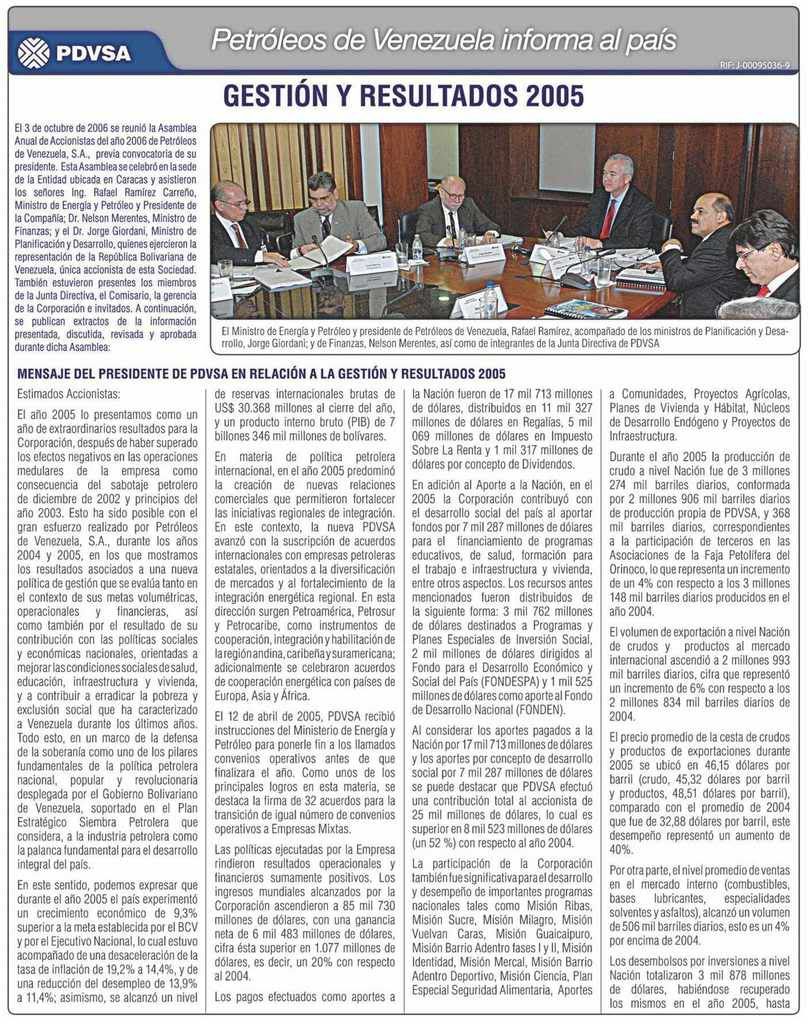
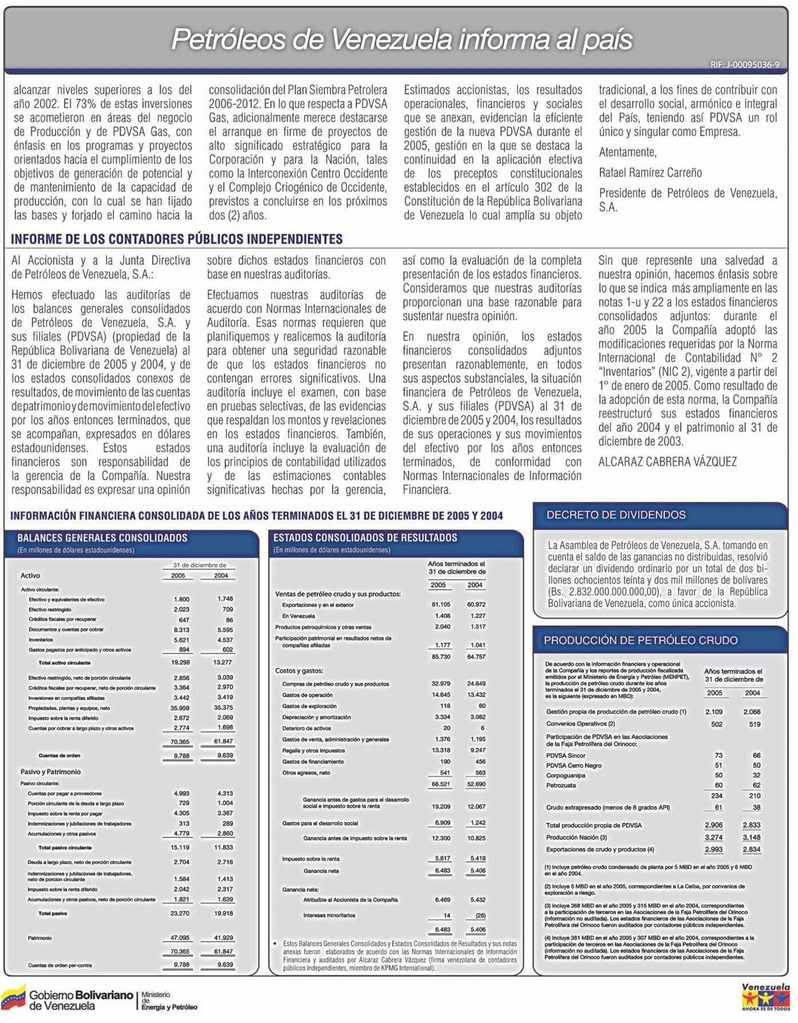
|
The very detailed financial statements should be up on the internet before to long and when they are they should provide a wealth of information given how much more forthcoming PDVSA is now then when previous administrations were running the place. I will therefore save my in depth analysis for when I have had a chance to review the actual financial statements.
There are two points I would like to make now though. First it appears PDVSA profits paid to the Venezuelan state were about $21 billion in 2004 which is pretty close to what I had calculated with my back of the envelope calculations. However in 2005 it is reported that PDVSA generated $32 billion for the government. That is significantly higher than the $25 billion I had calculated. Part of the problem is that I used as an average price $42 which is what Petroleumworld.com lists. But PDVSA says it was actually $46 dollars per barrel. So that accounts for some of the difference right there. Also, the tax and royalty rates on a lot of the foriegn oil company operations had increased significantly and I didn't have any way to account for that. My mistakes aside this is good news.
Also, the audited report shows that total Venezulean production was 3.274 Million Barrels per day - or just what Venezuela had said it was all along. Now as we know from all the discussions here international agencies pegged Venezuelan oil production for 2005 at 3.07 Million Barrels per day. So there is a difference, though not a big one. The likely cause for the difference is that the international figures are estimates that can't be expected to be precise. For example,from communication with various people it turns out they make their guestimates by counting how many oil tankers leave the country and estimating how much oil they are carrying. Of course, if domestic consumption of oil rises a person estimating oil production by tanker departures might not catch that as domestically consumed oil doesn't leave Venezuela on a tanker.
Lastly, this puts to bed all the non-sense about PDVSA being untransparent. It is now fully up to date with all its financial statements. The opposition supporters will now have to find something else to whine about.


|
Bridging the gap
Those familiar with Caracas will know it is a city that is in a fairly high mountain valley and that to get there from the coast (which is where the airport happens to be) requires a long drive up through mountain passes, through tunnels, and over very steep ravines. Earlier this year a bridge over one of the ravines, in-spite of intense efforts to save it, collapsed creating a traffic nightmare (for details on the old viaduct and what the route is like see this previous post).
Now the government is working furiously to build a new bridge over that ravine. The new bridge will be a good deal longer than the old one and instead of being an arched span will consist of spans over seven tall concrete tower. The first two towers are largely complete and the rest will have to begin rising soon to meet the completion deadline of April 2007. Lets look at the progress so far:
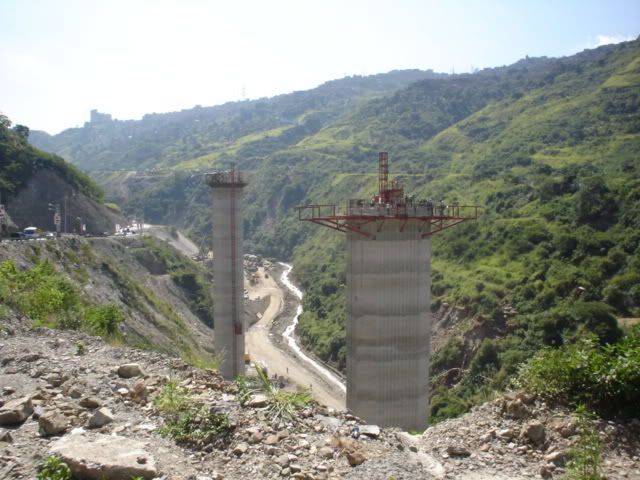
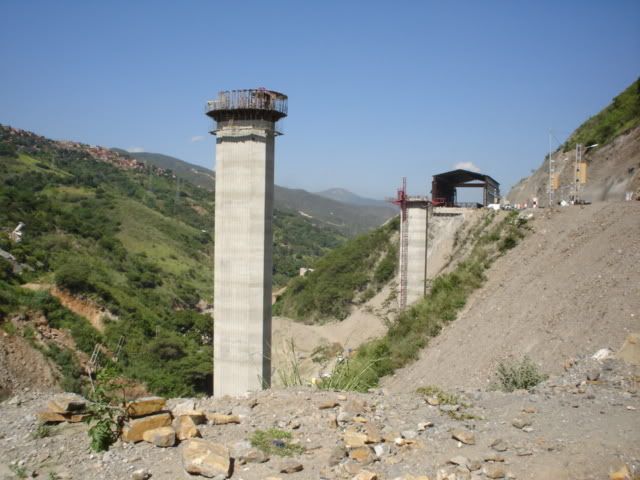
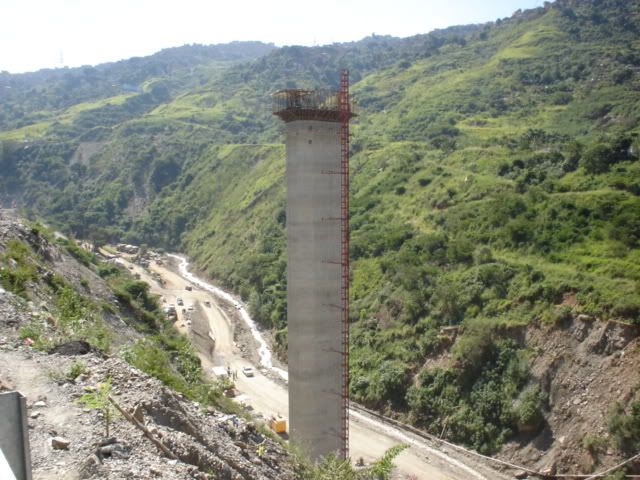
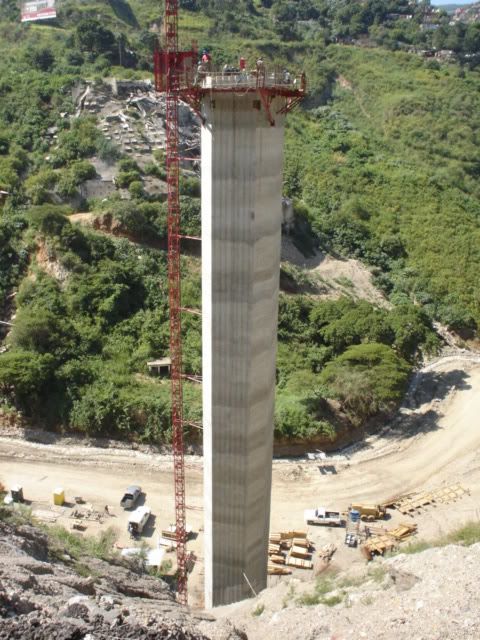
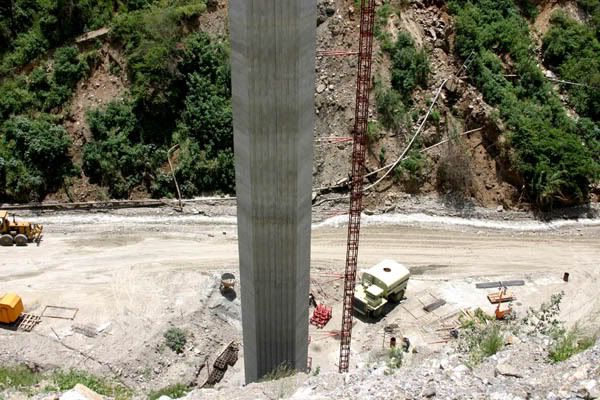
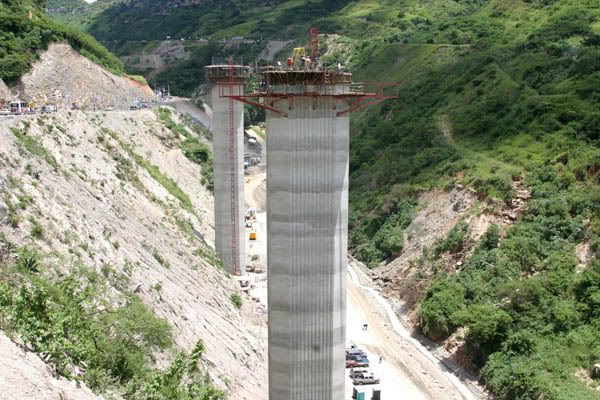
In this last picture you should be able to note something important – how steep the ravine wall right next to the towers is. It was precisely these steep ravine walls which slide ever downward with the rains that ultimately felled the original viaduct. So I have been wondering how they planned to guard against that with this bridge.
The answer can be seen in this picture:
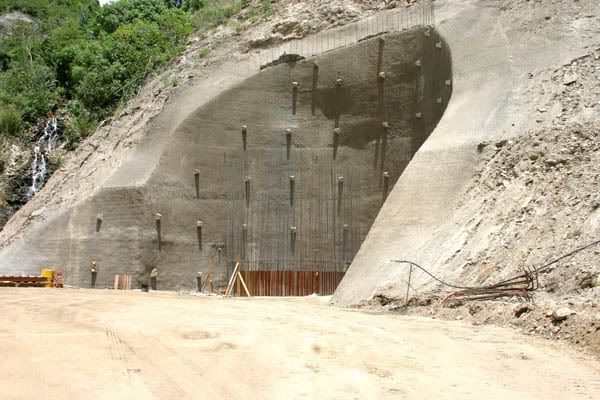
They have hallowed out the ravine wall around towers and put up a concrete wall with steel reinforcing beams that are drilled into the ravine wall. This should serve to protect the tower and at the very least if any damage is seen in the wall remedial action can be taken before it effects the towers. Looks like a lot of extra work but it also looks like a necessary solution - such are the challengers of building durable structures in such a challenging environment as Venezuela:
Here are some more pictures of those walls:
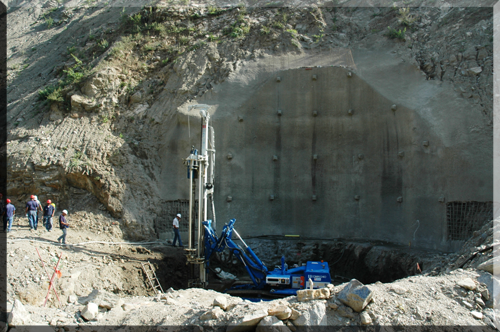

Look carefully in this picture and you can see several more of these walls already built where the other towers will be built:
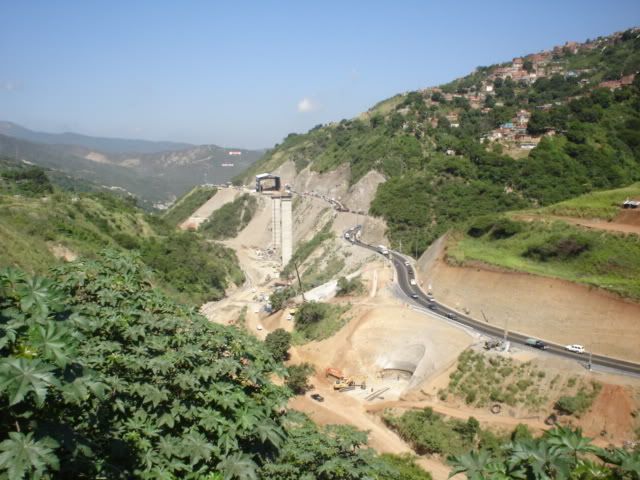
Finally here are some pictures of the work on the top of the towers as they rise:
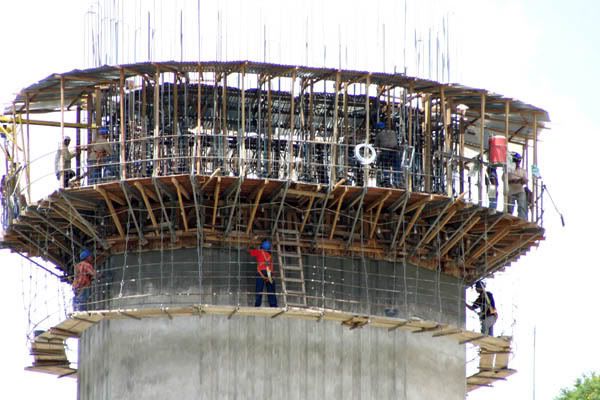
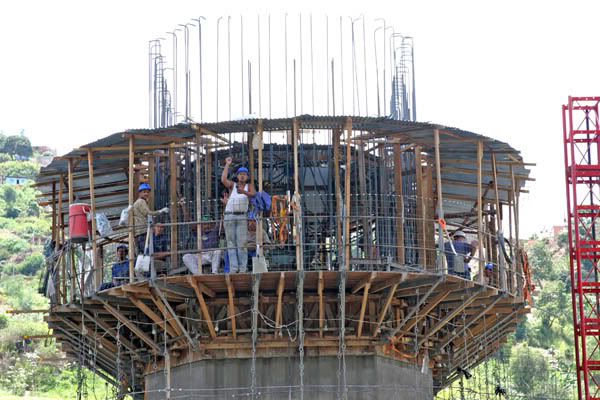
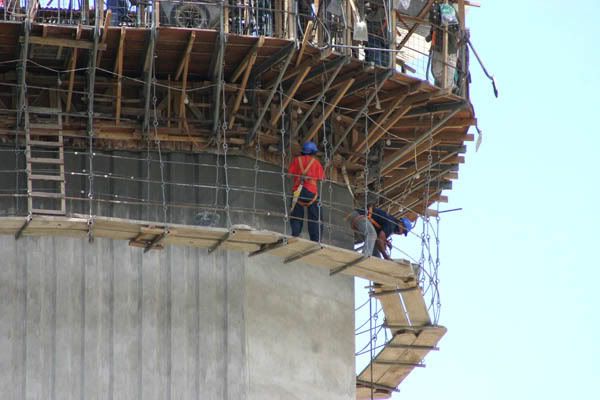
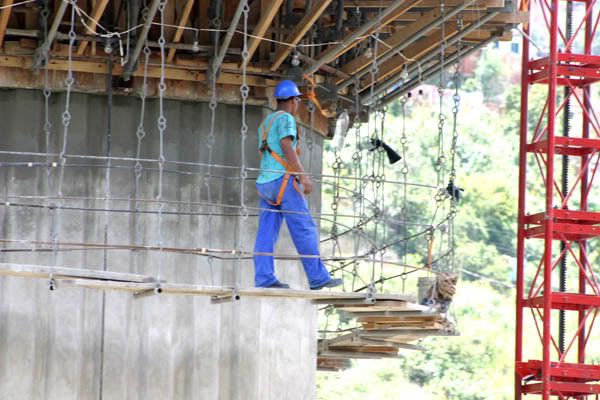
It’s interesting how the scaffolding is actually hung from the top of the tower as it rises rather than built all the way up from the bottom. I don’t think I’ve ever seen that before. Regardless, I won’t be applying for those jobs anytime soon.
|
Now the government is working furiously to build a new bridge over that ravine. The new bridge will be a good deal longer than the old one and instead of being an arched span will consist of spans over seven tall concrete tower. The first two towers are largely complete and the rest will have to begin rising soon to meet the completion deadline of April 2007. Lets look at the progress so far:






In this last picture you should be able to note something important – how steep the ravine wall right next to the towers is. It was precisely these steep ravine walls which slide ever downward with the rains that ultimately felled the original viaduct. So I have been wondering how they planned to guard against that with this bridge.
The answer can be seen in this picture:

They have hallowed out the ravine wall around towers and put up a concrete wall with steel reinforcing beams that are drilled into the ravine wall. This should serve to protect the tower and at the very least if any damage is seen in the wall remedial action can be taken before it effects the towers. Looks like a lot of extra work but it also looks like a necessary solution - such are the challengers of building durable structures in such a challenging environment as Venezuela:
Here are some more pictures of those walls:


Look carefully in this picture and you can see several more of these walls already built where the other towers will be built:

Finally here are some pictures of the work on the top of the towers as they rise:




It’s interesting how the scaffolding is actually hung from the top of the tower as it rises rather than built all the way up from the bottom. I don’t think I’ve ever seen that before. Regardless, I won’t be applying for those jobs anytime soon.
|
Tuesday, October 03, 2006
Power to the communities
Yesterday there appeared in the San Francisco Chronicle a very good article on Venezuela's anti-poverty programs and in particular its efforts to empower local community groups (hat tip Justin at LANR). The article casts a critical eye towards Chavez's economic and social policies and is one of the more balanced articles on what now is such a divisive subject:
Here are the pictures that accompany the article:
A community council meeting:
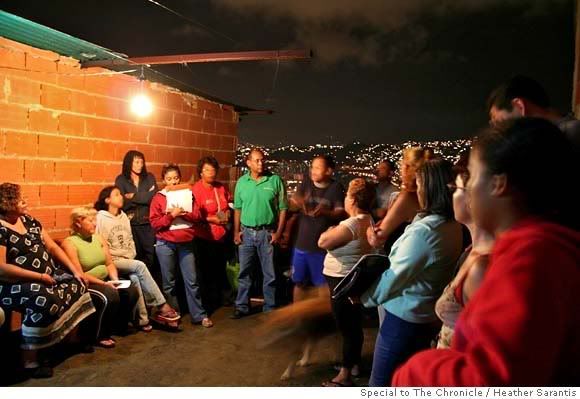
Workers taking a braek from laying a new water pipeline:
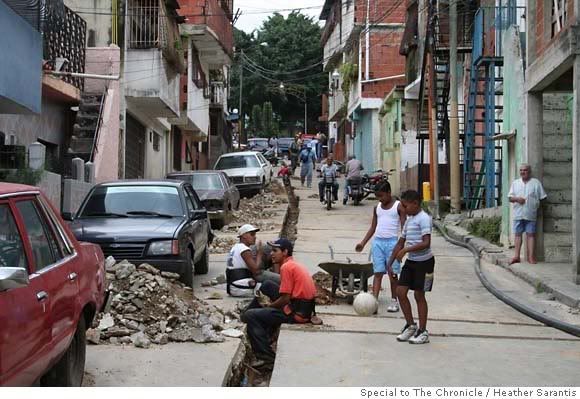
Distributing free lunches:
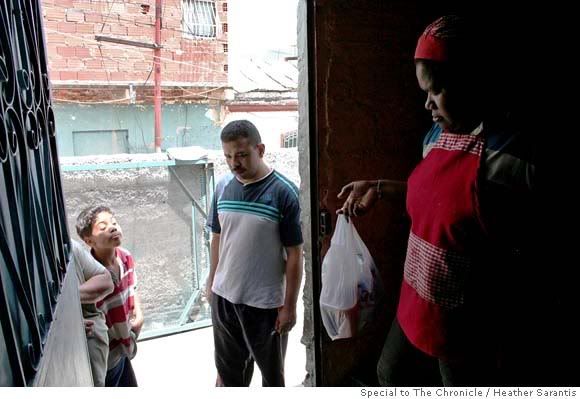
|
Venezuela's oil wealth funds gusher of anti-poverty projects
(Caracas, Venezuela) -- Hugo Chavez's revolution came to the hillside slum of San Juan one recent night in the glare of a solitary lightbulb and with puddles from a recent thunderstorm still underfoot.
Two dozen people clustered on a rooftop to debate the money and power that suddenly seemed within their grasp -- everything from home construction to bank loans, street repairs, and after-school and vacation recreation programs for children.
It was the first meeting of San Juan's communal council, an example of a new grassroots governing structure that is spreading across Venezuela. Like thousands of other such newly elected councils, the San Juan group will soon be given previously unheard of sums of money by the central government in what Chavez calls "a revolution within the revolution."
While the Venezuelan president has caused international controversy with his angry denunciations of the Bush administration, this is where the rubber meets the road for Chavez's radical rhetoric. He is spending billions of dollars on anti-poverty programs, in what experts say may amount to the largest such effort in a developing nation.
And in a gamble that turns part of his own government's power structure on its head, he is handing a large degree of authority over these spending programs to thousands of these elected local councils.
"The issues in these neighborhoods are very old fights -- water, land, decent housing," said Andres Antillano, a professor of social psychology and criminology at the Central University of Venezuela in Caracas who has been an adviser to many neighborhood groups.
"For many years, the only relationship with the state was the police. They came here and put everyone against the wall," Antillano said. "Chavez has chosen to gamble on legitimizing these issues. The communal councils are a very serious attempt at grassroots organizing."
The policy appears especially popular in the hard-bitten slums of Caracas -- although as is true elsewhere around the country, the electorate seems divided between a strongly pro-Chavez minority and an apathetic majority. San Juan's new council was chosen in local voting a week previously, with only 330 of the neighborhood's 916 eligible adult residents casting ballots.
"We like Chavez because he's giving us control," said Leomar Aquino, who had just been chosen head of the Education, Culture, Recreation and Sports Committee, one of a half-dozen such panels on the council. "If you don't want to participate in it, hey papito, that's your problem."
On this night, nobody seemed to know exactly how much their neighborhood would receive. Nor, the next day, did anyone at the offices of the local district government or in the central government buildings downtown.
What is certain, however, is that Venezuela's petroleum export earnings are rising rapidly, and the government is spending the money with abandon.
The government initially budgeted $857 million for social spending in 2006. But as oil money floods in, officials keep increasing the amount. It now stands at $7 billion, although many experts view that figure as a guesstimate of money being spent on the fly.
Public works projects are everywhere, ranging from subway lines in Caracas and Valencia to bridges over the Orinoco River. New medical clinics -- mostly staffed by Cuban doctors provided under Chavez's oil aid program to Fidel Castro -- are within reach of almost everyone in this nation of 25 million people. Illiteracy, formerly at 10 percent of the population, has been completely eliminated, and infant mortality has been cut from 21 deaths per 1,000 births to 16 per 1,000.
Another initiative that could change the lives of millions of poor Venezuelans is a new program aimed at increasing land ownership.
Venezuela is the most urbanized nation in Latin America, with about 86 percent of its people living in cities, but about one-third of those urban dwellers have no title to their land. In legal terms they are squatters, and thus cannot access many government programs.
Over the past year, 57 cooperatives of land surveyors have been formed to scour Caracas' hillside slums, measuring the sprawling neighborhoods that previously were merely blank spaces on official maps.
Ivan Martinez, director of the Urban Land Committee titling office for Caracas, said that more than 200,000 titles had been given out, involving about 1 million people.
"People now can get basic services," he said. "We can hook them up to water, electricity. We can help rebuild their houses. It's a huge change."
In San Juan, people are already hard at work.
Down the hillside from where the communal council was meeting, another council had already put its new powers to work. Using money and technical assistance from the state-owned oil company, PDVSA, and the water utility, Hidrocapital, it has hired local residents to install more than a mile of pipes in nearby streets.
"My street, around the corner there, was recently hooked up," said one worker, Beyser Bernal, putting down his shovel. "Before, we had it pirated, we hooked it to the main through a bunch of pipes that were broken, like those electricity wires," he said, pointing to a spider's nest of wiring overhead where residents had jury-rigged their homes into the electrical grid.
"The water just dripped out, and it was dirty. Now it comes out great, and it's clean. My whole family is happy."
But for many, progress is not happening fast enough -- and they blame the government.
"Chavez is working well," said Manuel Hernandez, a Caracas firefighter, who lives in San Juan. "My aunt was sent to Cuba to get her eyes operated on. But the people around Chavez are very bad. There is too much waste, too much corruption."
Chavez, who has been in power for seven years, often rails against the government bureaucracy as if he were an outsider. While Venezuela's government has long been known for its inefficiency, many people say the problem under Chavez has worsened.
At a ceremony April 9 to inaugurate the communal council program, Chavez acknowledged this perception.
"Many are saying that this is just Chavez's plan to corrupt the people, that now Chavez will spread money all around so people can go party and drink miche," he said, referring to a homemade liquor popular in the western mountains. "They say that everything will be wasted. But we're going to demonstrate what the Venezuelan people are capable of."
Some analysts point to the more than 100,000 cooperatives created under Chavez, a program that has broad public support yet also is viewed as having fostered waste and graft. They say the rules giving preference to cooperatives in the letting of state contracts -- including more than $200 million worth from PDVSA alone -- have prompted thousands of private companies to convert into cooperatives in name only.
"Chavez is spending so quickly, with such a lack of oversight, through a parallel state apparatus, that corruption easily could spin out of control," said Teri Karl, a political science professor and Latin America specialist at Stanford University.
Suspicions are so widespread that they have become the stuff of popular legend. Virtually every Venezuelan seems to know someone who formed a bogus cooperative in order to receive a large loan from a state-owned bank, then declared bankruptcy and pocketed the money, only to be allowed to repeat the process, milking the government for larger and larger sums.
"There is a problem of accountability, it's very true," said Griselda Olvero, president of the San Juan parish council, the local government for 110,000 residents in the San Juan area.
She spoke while busily signing checks in an office decorated by posters portraying leftist icons ranging from Yasser Arafat to Moammar Khadafy, Fidel Castro and Patty Hearst, along with Venezuelan independence hero, Francisco Miranda. The largesse went for public works and supply contracts, welfare assistance of all kinds, and one-off payments to "people with special needs, who asked for our help," she said. One of the checks was to a 10-year-old girl who played in a band so she could replace her broken violin.
"We're doing our best, but there is no way to track all this," she added as her assistants lined up at her desk with more checks to sign.
The result of all this spending has contributed to a red-hot economic boom, with gross domestic product growing at 9.3 percent last year and 9.6 percent for the first half of this year. And there's plenty more money to spend -- central bank reserves are at $36 billion, and other government rainy-day funds hold an estimated $15 billion. Inflation is 14 percent, a relatively moderate rate by traditional Venezuelan standards, and is held in check by subsidized prices at state-owned stores and by government price controls.
Chavez opponents accuse him of trying to buy loyalty. "This is a colossal waste of money," said Alberto Quiros, an oil industry analyst in Caracas. "Just when you think Chavez couldn't get farther from the laws of the market and common sense, he proves everyone wrong."
Stanford's Karl, who studies the development strategies of oil-producing nations, said Chavez's push to address poverty is "truly huge, and long overdue, but very risky."
"Because all this spending is not tied to any larger effort to increase economic competitiveness, because it's all based on the distribution of oil income, it's not at all sustainable," she said. "If the price of oil goes down, there could be a crash."
Chavez has said that although international oil prices have dropped recently, his spending programs can continue unimpeded as long as the international price of oil stays above $50 a barrel. As of Friday, the price was about $63.
For Chavez's supporters among the poor of San Juan, a big worry is making sure that the money for their own neighborhood doesn't get stolen.
"We're going to get huge amounts of money, and I barely know how to manage my own (home) budget," said the newly elected budget director, Hector Carvajal, speaking to his fellow council members on the rooftop. "Please, I need training. I don't want anyone to blame me for even one bolivar missing."
Here are the pictures that accompany the article:
A community council meeting:

Workers taking a braek from laying a new water pipeline:

Distributing free lunches:

|
Sunday, October 01, 2006
"One mistake after another"
In today’s edition of Petroleumworld they reproduce an editorial from the opposition business journal Veneconomy. The editorial, entitled “One mistake after another” has as its second sentence:
Given all the mistakes that are alledgadly being made I decided I better look into the numbers on oil revenues a little as Venezuela might be about to run out of money if things are indeed being run poorly.
In late August the state oil company PDVSA published its financial results from January through the end of July.
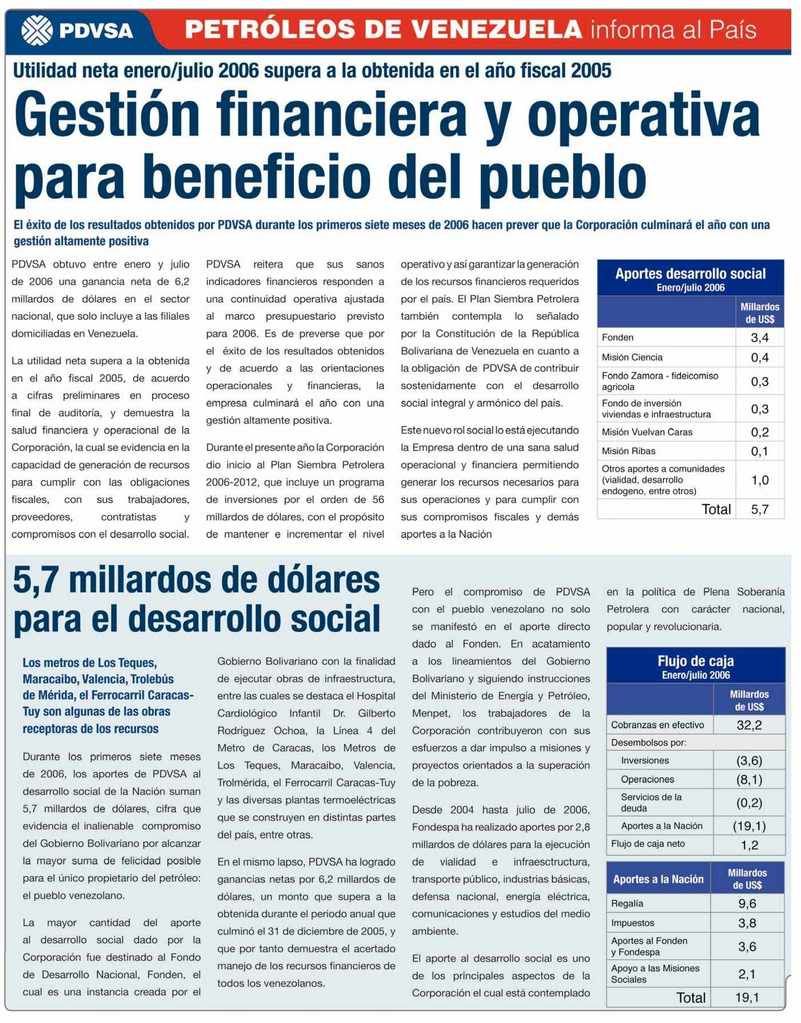
For the period January to July PDVSA had revenues of $32 billion dollars. Of that $32 billion $3.6 billion was invested back into the oil industry, another $8.1 billion was eaten up by operating costs and $200 million was paid in interest on its debt.
That leaves a balance of $20.3 billion dollars which can be thought of as “profits” – ie money that is available to the Venezuelan government. $1.2 billion of that money was kept on hand but $19.1 billion was turned over to the Venezuelan government. $13.4 billion was turned directly over to the government treasury via royalty and tax payments. Another $5.7 billion was split between the national development fund (Fonden) which got $3.4 billion and various Missions and other social programs which received $2.3 billion.
Now this $20.3 billion in government revenues from the oil industry through July comes to an annual rate of $34.8 billion. That is, if the oil income keeps coming in at the same rate the total government take at the end of the year will be $34.8 billion. How does this compare to prior years. Recall I previously published some numbers:
1997 $13.657 billion
1998 $ 4.343 billion
Chavez takes office
1999 $ 8.347 billion
2000 $17.950 billion
2001 $11.519 billion
2002 $8.487 billion
2003 $10.510 billion
2004 $20 billion
2005 $25 billion
And now 2006 will be about $34.8 billion.
In reality actual revenues will likely be somewhat less for a couple of reasons.
First in what is largely a symbolic move Venezuela has agreed, along with Nigeria, to make voluntary cuts in production, to help shore up prices. Venezuela’s portion of the cuts will come to about 50,000 barrels per day. I say these cuts are largely symbolic because they are, in and of themselves, too small to make much of a difference. When Venezuela made production cuts back in 1998 and 1999 along with other OPEC members to boost prices it cut daily production by more than 500,000. The current cut is less than one tenth of that – so don’t look for any dramatic effects. Most likely it is an effort to prod the rest of OPEC members to make deeper cuts to defend prices.
Venezuela has also decided to stop production on one of its least profitable types of oil, Orimulsion which is a type of fuel oil made by mixing very heavy oil from the Orinoco belt with water to make a liquid which is used in electric plant boilers. As this type of oil is not very profitable and displaces other types of oil which are much more profitable this the elimination of Orimulsion has long been expected. What is somewhat unclear is if this cut is on top of the other 50,000 barrel cutback or part of it.
With production somewhat lower and with prices declining recently its unlikely Venezuela will actually bring in revenues of $34.8 billion this year. But even if the final number is significantly lower, say $30 billion, that is still higher than last year and a LOT higher than the revenues which the previous government brought in.
So when all is said and done Veneconomy is just making the usual opposition hysterical claims of the sky is falling which when examined in detail turn out to have no merit at all. And while some may choose to see Venezuela’s oil policies as “one mistake after another” with profits going through the roof I bet General Motors and Ford shareholders wish they had management that would make these kind of mistakes.
|
With this decision, the Bolivarian administration has committed yet another, and this time irreversible, mistake in its management of the country’s oil policy.
Given all the mistakes that are alledgadly being made I decided I better look into the numbers on oil revenues a little as Venezuela might be about to run out of money if things are indeed being run poorly.
In late August the state oil company PDVSA published its financial results from January through the end of July.

For the period January to July PDVSA had revenues of $32 billion dollars. Of that $32 billion $3.6 billion was invested back into the oil industry, another $8.1 billion was eaten up by operating costs and $200 million was paid in interest on its debt.
That leaves a balance of $20.3 billion dollars which can be thought of as “profits” – ie money that is available to the Venezuelan government. $1.2 billion of that money was kept on hand but $19.1 billion was turned over to the Venezuelan government. $13.4 billion was turned directly over to the government treasury via royalty and tax payments. Another $5.7 billion was split between the national development fund (Fonden) which got $3.4 billion and various Missions and other social programs which received $2.3 billion.
Now this $20.3 billion in government revenues from the oil industry through July comes to an annual rate of $34.8 billion. That is, if the oil income keeps coming in at the same rate the total government take at the end of the year will be $34.8 billion. How does this compare to prior years. Recall I previously published some numbers:
1997 $13.657 billion
1998 $ 4.343 billion
Chavez takes office
1999 $ 8.347 billion
2000 $17.950 billion
2001 $11.519 billion
2002 $8.487 billion
2003 $10.510 billion
2004 $20 billion
2005 $25 billion
And now 2006 will be about $34.8 billion.
In reality actual revenues will likely be somewhat less for a couple of reasons.
First in what is largely a symbolic move Venezuela has agreed, along with Nigeria, to make voluntary cuts in production, to help shore up prices. Venezuela’s portion of the cuts will come to about 50,000 barrels per day. I say these cuts are largely symbolic because they are, in and of themselves, too small to make much of a difference. When Venezuela made production cuts back in 1998 and 1999 along with other OPEC members to boost prices it cut daily production by more than 500,000. The current cut is less than one tenth of that – so don’t look for any dramatic effects. Most likely it is an effort to prod the rest of OPEC members to make deeper cuts to defend prices.
Venezuela has also decided to stop production on one of its least profitable types of oil, Orimulsion which is a type of fuel oil made by mixing very heavy oil from the Orinoco belt with water to make a liquid which is used in electric plant boilers. As this type of oil is not very profitable and displaces other types of oil which are much more profitable this the elimination of Orimulsion has long been expected. What is somewhat unclear is if this cut is on top of the other 50,000 barrel cutback or part of it.
With production somewhat lower and with prices declining recently its unlikely Venezuela will actually bring in revenues of $34.8 billion this year. But even if the final number is significantly lower, say $30 billion, that is still higher than last year and a LOT higher than the revenues which the previous government brought in.
So when all is said and done Veneconomy is just making the usual opposition hysterical claims of the sky is falling which when examined in detail turn out to have no merit at all. And while some may choose to see Venezuela’s oil policies as “one mistake after another” with profits going through the roof I bet General Motors and Ford shareholders wish they had management that would make these kind of mistakes.
|
